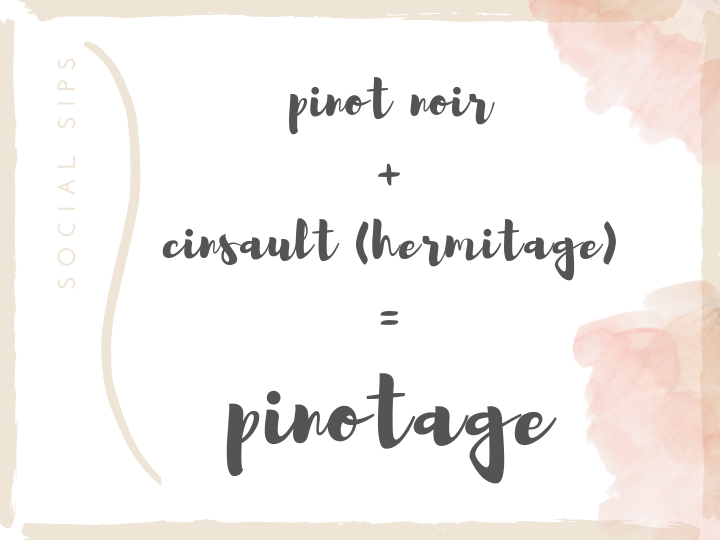I’ve been posting wine tips, tasting tricks and flagship varieties to my Instagram feed recently and not too long ago I posted about Pinotage. The post resulted in a few direct messages because as it turns out, people don’t know that much about the Pinotage grape!
In honour of International Pinotage Day this Saturday, Oct 10th (there’s a day for everything, isn’t there?), let’s explore a few things about the Pinotage grape and what makes it so unique.
But First, Let’s Start with an Embarrassing Story
Ten years ago, I was the marketing and sales coordinator for a wine agency. Up until then, I’d had a little experience behind a winery tasting bar but hadn’t yet completed my WSET level 2. As a result, my knowledge of global varieties was pretty slim.
I was asked to create a sell sheet for a South African Pinotage and started doing some research. A quick search on the internet let me to discover that the Pinotage grape is a cross between Cinsault and Pinot Noir. In my ignorance, I read that to mean that it was a blend.
News flash! Cross and blend are not interchangeable. In fact, a crossing and a blend are very different things. So, let me spare you the embarrassment that I experienced after presenting my sell sheet to the sales team. Let’s take a quick moment and look at the differences between the two.
Cross vs Blend
A crossing is when a new variety is produced from two parents of the same species. We’re talking about vines at this point: roots, leaves and berries. In the instance of Pinotage, its parents are two French varieties: Pinot Noir and Cinsault (or Hermitage as it was once called). The Pinotage crossing happened almost 100 years ago at the Stellenbosch University by the first Professor of Viticulture, Professor Abraham Perold. He planted the seeds for the crossing in his experimental farm in 1925. However, he left his position at the University, and the garden, in 1927. Fortunately, someone else at the University knew of the planting and created a graft of the vine in 1935. The first Pinotage wine was then vinified in 1941.
In contrast, a blend is the result of combining the juice of the grapes. We’re talking about liquid at this point, not vines. Blending can happen at any stage of the winemaking process. If you were to blend Pinot Noir and Cinsault, you would NOT get Pinotage. You would get a Pinot Noir Cinsault blended wine.
A Bit About Pinotage
You would think that the offspring of two varieties would exhibit comparable characteristics of each kind. That is not the case with Pinotage. Much like a child gets equal parts DNA from each of his or her parents, a lot of the child’s personality is developed over time by influences from its environment and experiences. Grapes are the same!
To explain what I mean, I’ve created a grid showcasing Pinot Noir and Cinsault and the resulting unique characteristics of the Pinotage grape.
| PINOT NOIR | CINSAULT | PINOTAGE | |
| PRIMARY AROMAS & FLAVOURS | raspberry cherry clove & all spice hibiscus | raspberry red currant violet black tea | black cherry blackberry menthol sweet tobacco |
| TASTE | dry | dry | also dry |
| BODY | light to medium | light to medium | full |
| TANNINS | low | low | medium to high |
| ACIDITY | medium to high | medium | low |
| ABV | 11.5 – 13.5 % | 11.5 – 13.5 % | 15% + |
Highlighting Its Unique Attributes
What’s fantastic about the marriage of Pinot Noir and Cinsault is that the best of each variety is in Pinotage. Pinot Noir is known for its fruit-driven structure. However, the grape itself is quite challenging to grow in certain climates. Cinsault, on the other hand, is much more resilient and provides the heartiness needed that allows Pinotage to thrive in South African heat.
The interesting standout about the above grid is that despite the light body and low tannins in both Pinot Noir and Cinsault, Pinotage traditionally expresses quite a full body in addition to robust and bold tannins. While I haven’t been able to find any direct research to support my theory, I believe this contrast is because the Pinotage grape has evolved to thrive in the South African climate. A resilient, thicker and darker grape skin is needed to combat potential sunburn. Those qualities then equate into heavy tannins and a fuller-bodied wine.
Even though Pinotage has become a flagship variety of South Africa, its plantings make up less than ten percent of vines in the region. While single-variety expressions are usually easy to find, Pinotage is a vital component of Cape Blends. In a Cape Blend, the Pinotage portion must range anywhere from 30-70% of the final composition. This variance gives winemakers flexibility to produce a style suited to their strengths and allow the Pinotage to shine or support as needed.

